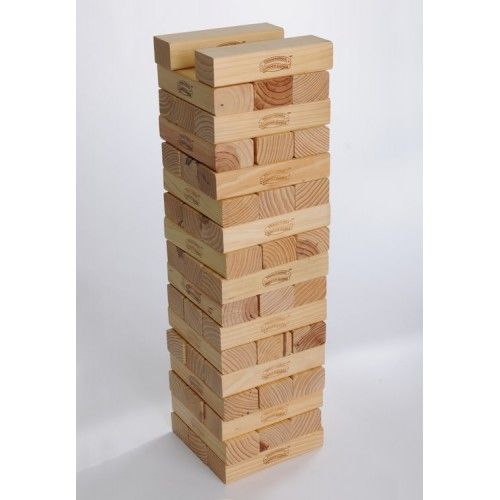Boxed Topics, Jenga Towers, And The Spacing Effect.
An undergraduate class on molecular biology teaches you about DNA transcription, the Golgi apparatus, cancer, and integral membrane proteins. Sometimes, these sub-topics are connected. But most often, they're presented in separate chapters, each in its own little box. So let's call these Boxed Topics.

The well-known Stewart calculus textbook teaches you about functions in chapter 1, limits and the definition of derivatives in chapter 2, rules for derivatives in chapter 3, and the relationship of derivatives with graphs in chapter 4. Woe betide you if you weren't entirely clear on the definition of a derivative when it gets used, over and over again, in next week's proofs of derivative rules.
Taking a calculus class can be like building a Jenga Tower. If you've never played it, Jenga is a game where two players share a tower of wooden blocks in crisscrossing layers of three blocks. They take turns removing one block out of middle of the tower, and putting it on top. The towers get taller and less stable every turn. The person who collapses the tower loses.
In a Jenga Tower Topic, the blocks of last week's memories get pulled out, and placed back on top of the tower as you learn new material that depends on them. You just hope it doesn't collapse before the end of the class.

One is not necessarily easier than the other. A Boxed Topic that's jam-packed with disorganized information can be a lot harder than a well-structured and manageable Jenga Tower.
But all else being equal, Jenga Towers have trouble dealing with the spacing effect. This is the well-established finding that people build memories better by spacing out their practice, rather than massing it all together at once.
This might seem counterintuitive. With a Boxed Topic like molecular biology, you get all your practice on the Golgi apparatus in week 5, and all your practice on cancer in week 12. That's a perfect example of massed practice. It seems like Boxed Topics should have the most trouble with the spacing effect.
By contrast, Jenga Towers, like calculus, give you sustained practice with the early material. You learn about functions in week 1, and you continue using them throughout the course. You learn the definition of the derivative in chapter 2, and it keeps popping up over the long term. That sounds like a built-in form of spaced practice, which should make them easier to learn.
To go further with this objection, homework and quizzes for Boxed Topics and Jenga Towers are typically on whatever students learned most recently. This encourages massed practice, no matter whether the topic is boxed or in a tower.
Let me explain why I still think that Jenga Tower Topics have a bigger problem with the spacing effect than Boxed Topics, despite these objections.
While Jenga Towers do give you lots of practice with the earlier material, it is almost always in the context of presenting more complex concepts that depend on what you most recently studied.
You learn a simple idea. That's not so hard. But you'd better have a firm grasp on it very quickly. Because next week, your mind will be crowded with more complex ideas that absolutely depend on it. And then you'll have to take those more complex ideas, synthesize them, and use that to comprehend something even more complicated.
Even if you can build that tower very high without it collapsing, you don't want to build a career as, say, an engineer, on such a shaky structure.

With a Boxed Topic, you can move on to Box 2 without worrying if you've mastered Box 1. You can just review Box 1 at your leisure. This is why they're more compatible with the spacing effect.
With a Jenga Tower, no such luck. You'd better mass your practice heavily on whatever you're learning this week, because it's going to be foundational for next week, which will be foundational for what follows, and so on.
Imagine you take a year off of school for self-study. You decide to teach yourself three units of Boxed Topics and three units of Jenga Tower Topics during that time. Knowing about the spacing effect, you want to space out your practice sessions on each topic.
This is easy to do for the Boxed Topic. At first, you read straight through the textbooks for each topic, without worrying about remembering much as you go or trying to grasp all the fine details. This takes a month or two.
Then you have over half a year left to go back over the material. You can touch on each chapter once every week or two. In six months, you can re-study each chapter perhaps 8 times. The spacing effect promises that you'll reap much greater dividends than if you'd spent week 1 exclusively studying chapter 1, week 2 on chapter 2, and so on. Yet it's the same amount of work, on the same amount of material. You're just not pushing your brain to master any particular sub-topic in an unnaturally compressed time period.
By contrast, you'll have a very hard time with this strategy for the Jenga Tower Topics. My Calc I-III classes covered a total of about 14 chapters out of the Stewart textbook. Go ahead and try reading them all right straight through, without stopping to focus hard on the individual details along the way, and without doing problems to reinforce your learning. You're gonna have a bad time. That's because calculus is a Jenga Tower Topic.
So what does the devoted autodidact do with Jenga Tower Topics?
The solution is actually simple. Study several at the same time!
Wait, what? You want me to make life easier on myself by, instead of studying calculus, studying calculus, linear algebra, and statistics all at once?
Well, yes, but just a little bit of each one.
There's a certain amount of material in any given subject that you can start to pick up in a casual, just-read-through-it sort of manner. It might be one chapter, just one section of a chapter, or even less. Call this an "Easy Chunk," because it's the most you can learn in one go that doesn't require extreme, detailed focus to get something out of it. You pick up some vocabulary, some general ideas, and perhaps nothing more on your first go 'round.
So pick up your calculus, linear algebra, and statistics textbooks, and read an Easy Chunk. That's your practice for day 1.
Effectively, you're turning several Jenga Tower Topics into a single big Boxed Topic. You learn a little from each one at a time, but you're not trying to integrate them. In theory, over 4 years, you could take the same amount of material. But instead of doing three calculus classes in year 1, three statistics classes in year 2, and three linear algebra classes in year 3, you'd take a class that combines a little of each every year for all three years.
In this way, some of the dependencies are de-coupled. Beginners in college-level math would learn about functions, the basics of linear systems, and the difference between quantitative and qualitative data, all at the same time.
The Multi-Tower Study Strategy
It might be easiest to start by showing you, in the abstract, how these approaches might work. Call this the Multi-Tower Strategy, because the idea is that we study several Jenga Tower topics slowly, at the same time, rather than sequentially, one after the ther.
Let's say that every week, a student can learn five ideas, one per week day.
If they're studying calculus, they can learn C1, C2, C3, C4, and C5. In statistics, they can learn S1-S5. In linear algebra, they can learn L1-L5.
Because these are all Jenga Tower Topics, C2 depends on C1, while C3 depends on C2. Let's represent this as C1 -> C2 -> C3 -> C4 -> C5. Likewise, S1 -> S2 -> S3 -> S4 -> S5 and L1 -> L2 -> L3 -> L4 -> L5.
Now, in a conventional math class, this is exactly how students learn. In week 1, the calculus student studies this:
C1 -> C2 -> C3 -> C4 -> C5
By the time Friday rolls around, they're trying to understand C5, a topic that depends on earlier concepts they learned just four days ago. Even if they had a bit of time each day to review the previous day's material, that's the least possible amount of spacing between their practice sessions.
Let's compare this to an approach to learning that mixes three different math topics together. In week 1, the student studies like this:
C1, S1, L1, -> C2, -> S2
That's a little hard to understand with the arrows, but it's just meant to remind you that when they learn C2 on Thursday and S2 on Friday, these topics depend on topics C1 and S1 that they learned earlier in the week. But now, the student has had two full days in between to learn other, unrelated material. When they do a little bit of review on C1 on Thursday prior to diving into C2, the spacing effect is making that review go much further.
This is not new or fragile science. Again, the spacing effect is one of the oldest, best-studied, strongest findings in the psychology of learning. Our unconventional math student might feel on Thursday like she's having a harder time remembering how C1 worked when she learned it three days prior, that's true. By contrast, the conventional math student feels on Tuesday like he remembers C1 pretty well, since he just learned it the day before.
But psychological science tells us that at the end of three years, although both students will have covered the same material in the same amount of time, the unconventional student who used the Multi-Tower approach will remember it all much better.
Wouldn't this be confusing?
We might theorize that calculus, statistics, and linear algebra are such different subjects that students might really struggle to shift gears on a daily basis.
This objection is easy to dismiss. After all, many students take very different subjects simultaneously. A bioengineering student might take a biology, chemistry, and mathematics class all at the same time, and nobody bats an eye.
Or perhaps the problem is that these math classes are too similar? But then again, it's no problem if a student takes organic chemistry, biochemistry, and molecular biology simultaneously. Not to mention a simultaneous set of classes on French poetry, French literature, and French philosophy!
Why should mathematics be any different?
Micro-Jenga Towers
We can find "Jenga Tower" structures even at the level of the individual sentence. Consider the following description of enzymatic regulation from Anthony-Cahill's Biochemistry textbook.
If an enzyme molecule can exist in two conformational states (T and R) that differ dramatically in the strength with which substrate is bound or in the catalytic rate, then its kinetics can be controlled by any other substance that, in binding to the protein, alters the T <=> R equilibrium.
Now let's break the same sentence apart so that we can see the way that later clauses depend on earlier ones:
- If an enzyme molecule can exist in two conformational states (T and R)
- a) that differ dramatically in the strength with which substrate is bound b) or in the catalytic rate
- then its kinetics can be controlled
- by any other substance that, in binding to the protein,
- alters the T ∆ R equilibrium.
You might have divided this sentence up a bit differently than I did. But you can still see how the "meaningfulness" of each phrase, in context, depends on what came before. Step 2 is bifurcated, which is hard to parse!
This sentence alone is at risk of using up all seven-odd slots in your working memory.
Why is mathematics a young person's game?
I'm going out on a limb here for a minute.
There's a story in psychology, and I believe it, that young children have brains that are far more plastic than those of adults. They learn and remember far better than older people. Perhaps it is for this reason that math is a "young person's game." Kids can remember new math much more easily than adults, whose intelligence is less fluid and more crystallized. They can cope more easily with the relentless onslaught, with building the Jenga Tower to the point that they can push the boundaries of the field further in their late teens and 20s.
This is probably an important factor for learning generally, but why does math specifically have a reputation as a "young person's game" when other intellectually demanding fields do not?
Perhaps it's at least partly because we take a Jenga Tower approach to teaching math more than we do in any other subject.
And perhaps we do this, in turn, because the structure of the subject itself seems to lend itself to the Jenga Tower approach so naturally, as proof follows proof follows proof. Reaching down from their lofty heights of knowledge, the math teacher wants to reach down and scoop the best and brightest up to their level as quickly as possible.
Other subjects lend themselves more naturally to being boxed. Molecular biology can focus on a specific organelle, protein type, or pathway at a time. It can gesture at connections, but present them in a way that is fundamentally decoupled. If a student is learning about how a certain signaling molecule triggers apoptosis in a cancerous cell, then don't need to recall the exact structure and mechanism of action of the integral membrane protein that is its receptor.
When molecular biology students move on to the next topic, it's without the stress of worrying that what's to come depends on a mastery of what they just studied. When they review, it's with the benefit of the spacing effect.
Conclusion
These ideas about Boxed, Jenga Tower, and Multi-Tower strategies are based on my experience as a teacher, student, autodidact, and study of learning psychology. They make sense, are grounded in established research, and reflect how I am structuring my own self-study. I've been scrutinizing and refining my approach to study over the last two years, and have plans to turn it into a sequence that fully explains the techniques, theory, and underlying science behind the project.
Individual anecdotes and experiences with learning are valuable and interesting. However, there are many variables at play in each individual circumstances. Just because I use the Multi-Tower strategy and find it helpful, or just because you tried it and it didn't work for you, isn't a strong point of evidence one way or the other about which is best.
That depends on which makes the most sense based on what we know about learning psychology, the practical details of a learning effort, and whatever empirical evidence might exist on the subject. It's these forms of evidence that I'm most interested in to develop these ideas further.
Stay tuned over the next year for more posts in my forthcoming Sequence on Scholarship.
Scholarly Support
Rohrer, D., & Taylor, K. (2006): Spaced practice, but not overlearning, had an "extremely large" beneficial effect on mathematics learning of moderate conceptual difficulty on a test administered four weeks after the last practice session.
Rohrer, D., & Taylor, K. (2007): Spaced rather than massed mathematics problems sets produced "much greater" performance; randomly mixed math problems produced "vastly superior" performance as compared to problem sets blocked by type.